[This post was written by our CEO, Stewart Butterfield, as soon as he was allowed to, following the end of our Q3 quiet period]
Shared channels are amazing. They bring all the benefits of moving from inbox-based to channel-based communication — the increase in transparency, in alignment, the shared history equally accessible to everyone regardless of when they join the project — they bring all of that to teams of people that are working across organizational boundaries.
Shared channels help sales teams close deals faster and lawyers serve clients better. They create more efficient relationships between marketers and the creative agencies with whom they partner. They help customer support teams deliver better service, they help consultants deliver on projects faster, and they help procurement teams working with many vendors in complex supply chains to improve productivity — the list of ways they help to get work done is very long, and growing every day.
Because of all that, shared channels have been an enormous hit with customers. As of October 31st, more than 26,000 companies have created more than 70,000 shared channels. Here’s a network map that shows how all those connections come together:
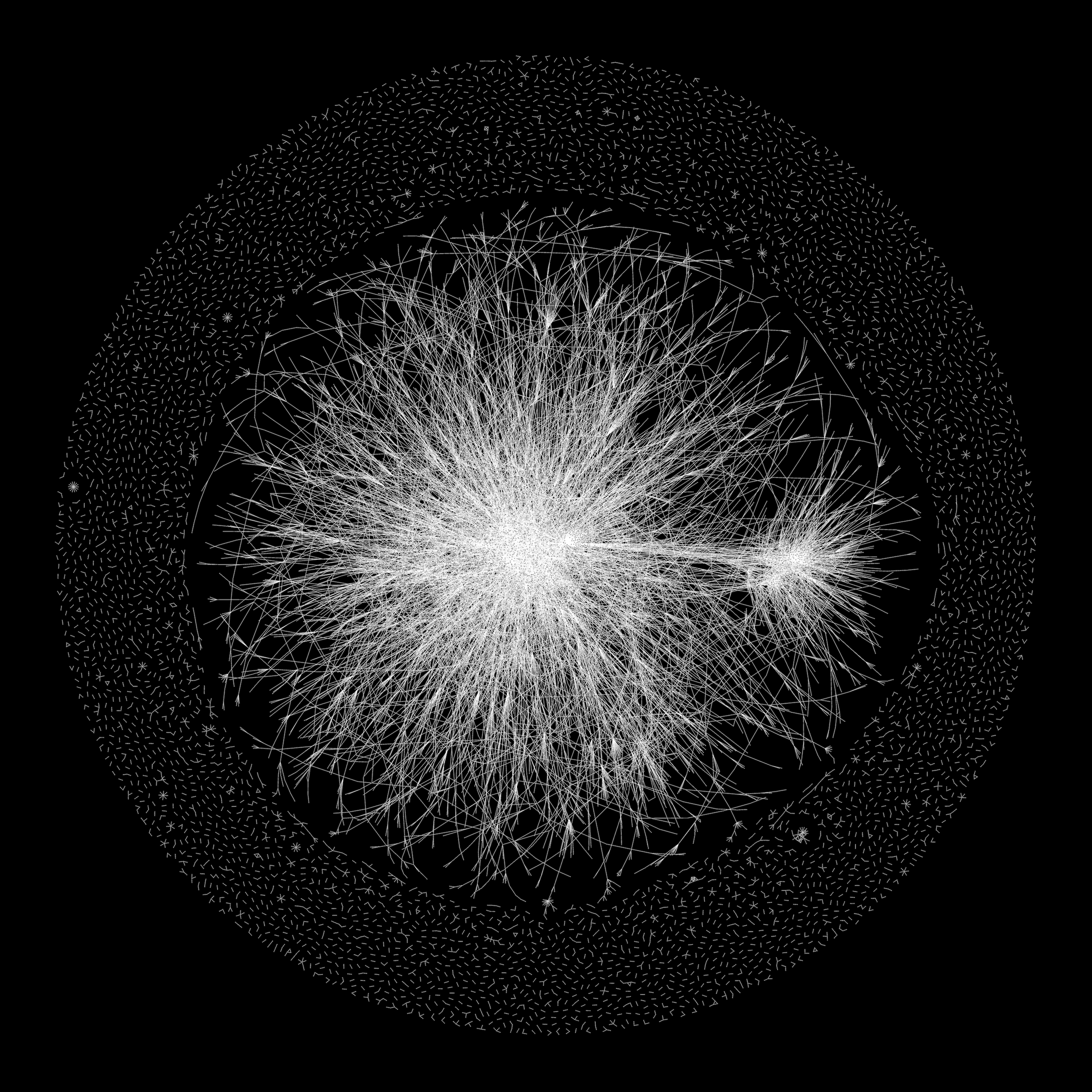
Pretty complex, huh? (Also: cool-looking.) This week, millions of messages will be posted by hundreds of thousands of users across a vast network of shared channels in 138 different countries around the world. But those summary numbers don’t really tell the whole story. So, let’s break it down.
First, you’ll see there are two parts to the network. On the inside there is the “internal mega network” (naming suggestions welcome). Every company in this group is connected to every other one by some chain of shared channels. It is very dense and looks like this:

In the outer ring, you find a sea of floating “constellations” made up of mini-networks who have no connection yet to any of the organizations in the internal mega-network. It looks like this:

Like constellations in the night sky, these mini-networks have distinctive shapes (and we can’t stop giving them names like “trident,” “scoop,” “worm,” “twig” and “wheel”). On an hourly basis, new pairs are created, new constellations are born, and the existing shapes evolve as new organizations start using shared channels.
Also on an hourly basis, these mini-networks from the outer ring get sucked into the internal mega-network, as connections are formed between organizations on the inside and the outside. The overall result is a roiling sea of proto-networks surrounding an ever-expanding network of super-connected teams.
Of course, that’s just a way to try to visualize a massive transformation in how individual companies work together and, ultimately, how entire industries will reshape the way teams collaborate and work gets done. But in the meantime, again: it looks cool. And you can get a good sense of how the network has grown by looking at snapshots from different times.
First, have a look at the shared channels “pioneers” who were testing the feature in the very early days, just under two years ago:
 Above: 4,175 shared channels-using organizations and their connections as of December 31, 2017. Note: For simplicity, in this and the historical snapshots that follow, we are only counting and showing the shared channels and their corresponding organizations that are still in active use today.
Above: 4,175 shared channels-using organizations and their connections as of December 31, 2017. Note: For simplicity, in this and the historical snapshots that follow, we are only counting and showing the shared channels and their corresponding organizations that are still in active use today.Six months later, with the official beta program up and running, more teams were allowed in and the mega-network started to emerge as a core group of customers starting linking more tightly together:
 Above: 9,845 shared channels-using organizations and their connections on June 30, 2018.
Above: 9,845 shared channels-using organizations and their connections on June 30, 2018.By the end of 2018, the number of companies in the network had nearly doubled and around a quarter of the teams were part of the mega-network and the network map started to resemble the current form:
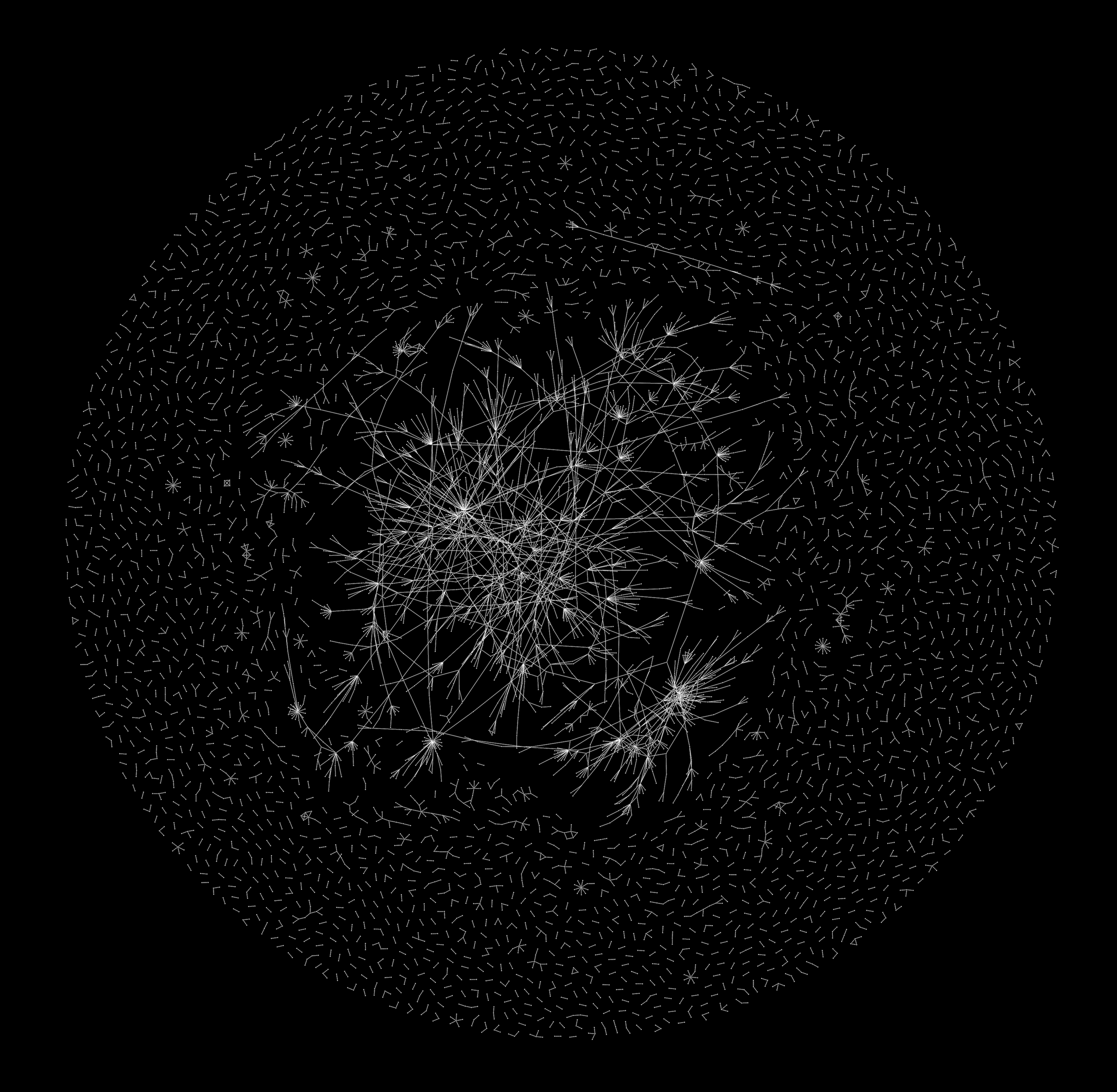 Above: 15,093 shared channels-using organizations and their connections on December 31, 2018.
Above: 15,093 shared channels-using organizations and their connections on December 31, 2018.In early 2019 we started simplifying the set-up process and began encouraging more organizations to participate (though the beta was not yet available to customers using our Enterprise Grid product):
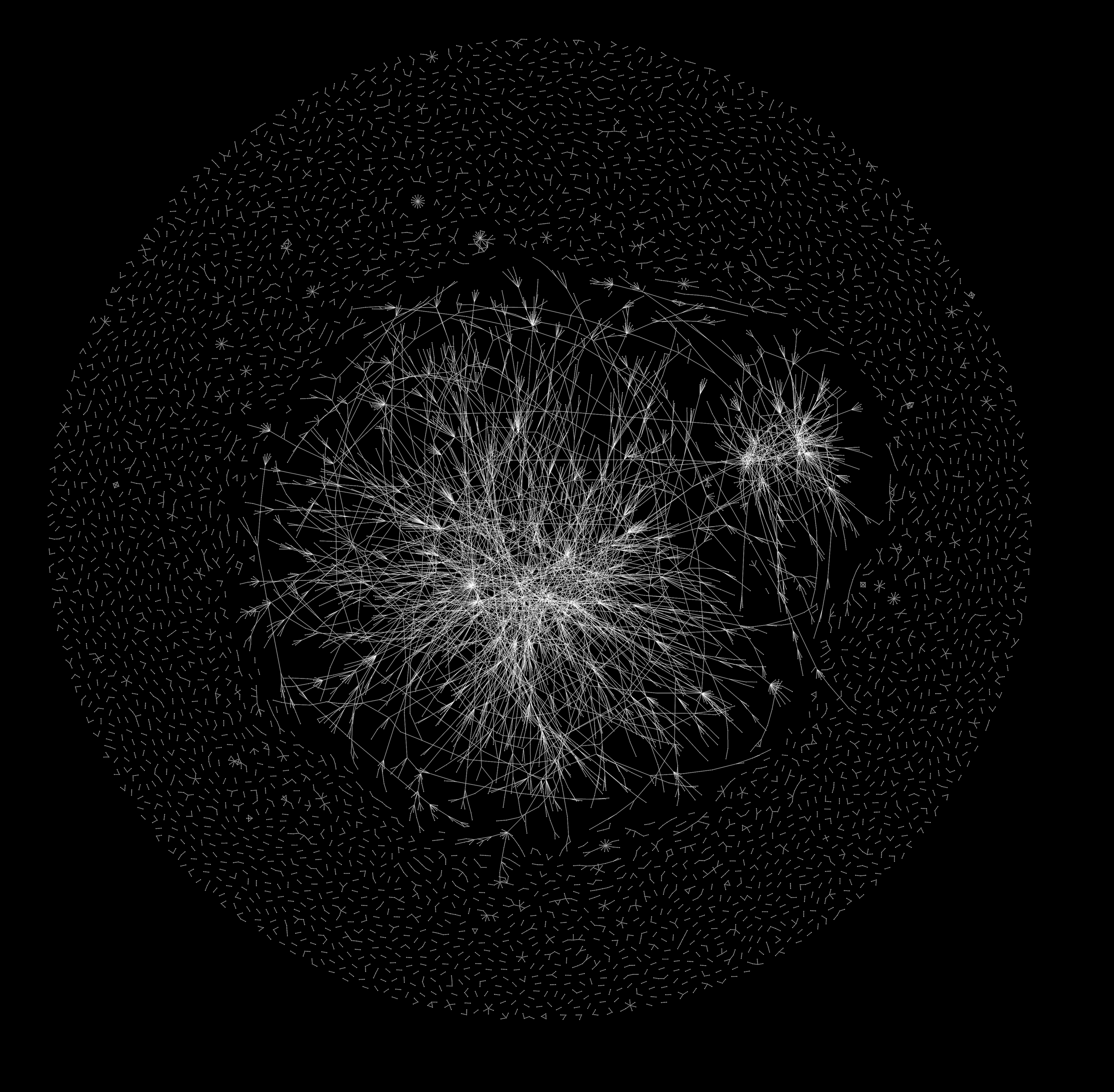 Above: 19,359 shared channels-using organizations and their connections on April 30, 2019.
Above: 19,359 shared channels-using organizations and their connections on April 30, 2019.By July 31st 2019, more than two thirds of teams had joined the central network, we had started to allow Enterprise Grid customers to test shared channels and we were about ten weeks out from “general availability,” the official launch of the feature out of beta:
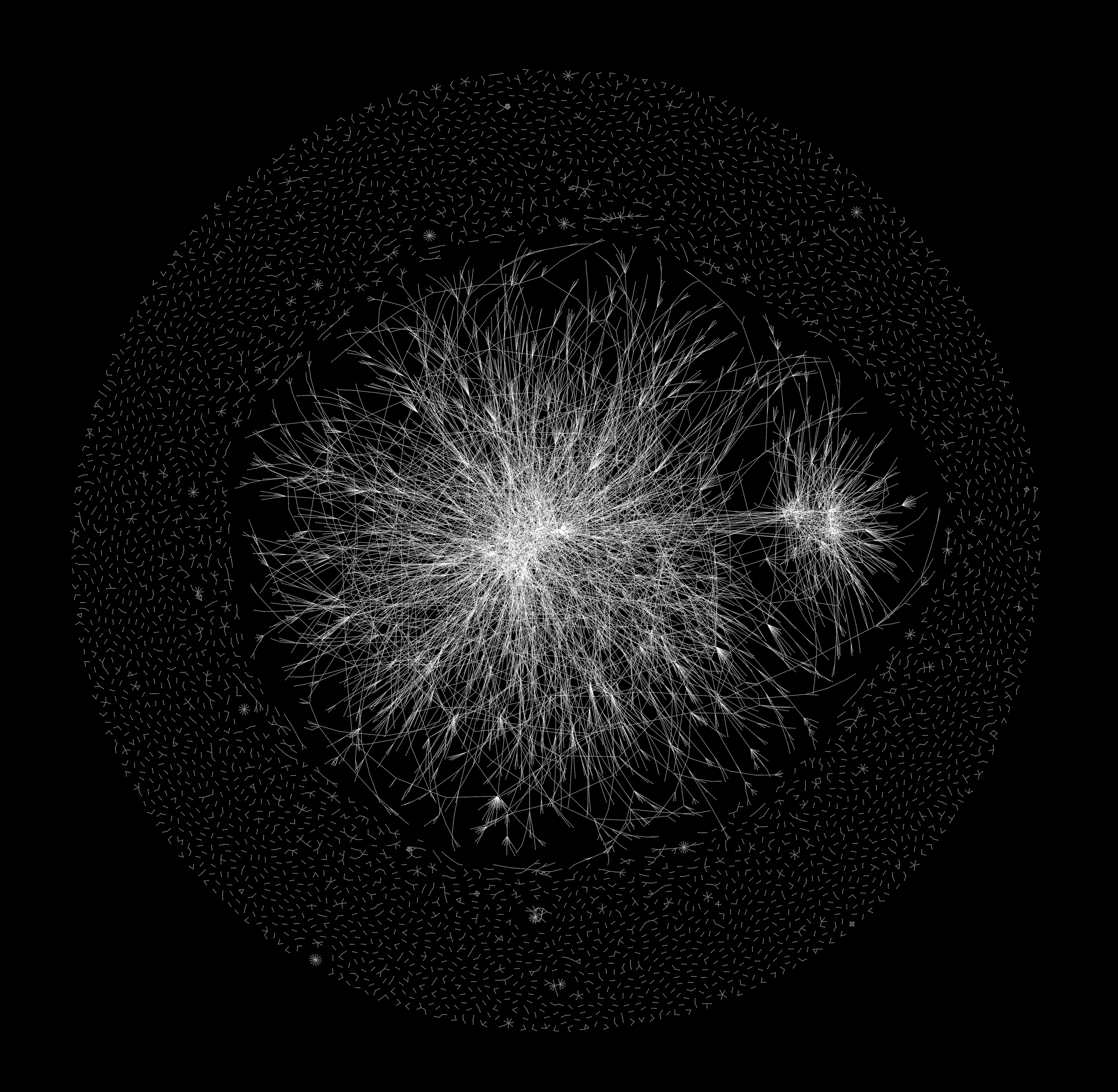 Above: Over 20,000 shared channels-using organizations and their connections on July 31, 2019.
Above: Over 20,000 shared channels-using organizations and their connections on July 31, 2019.Finally, just before the end of our last quarter, six weeks after GA, usage began to explode and we’re back at the network map we shared at the beginning of this post:

Above: Over 26,000 shared channels-using organizations and their connections on October 31, 2019.
Zooming in, we can see all kinds of interesting phenomena begin to emerge. The big branch of the mega-network jutting off to the right? That’s our Japanese users who share much more frequently in-country than North Americans or Europeans. The “wheels” around the outside, once sucked into the mega-network, become the arrowhead wedge shapes jutting out of the center. The number of connections between companies starts to grow even more quickly than the number of participants as customers begin finding new uses for shared channels.
But the network map only tells part of the story. The really interesting stories are being created through the connections among individual companies. For just one example, look at the “wheel” in the middle of this image:

The hub in the middle of that wheel, connecting to all the spokes, is an audiology software company called Smartcare.
Smartcare has changed the way they work with their customers through shared channels – and their customers love it. They are so happy about the results that they bring all new customers into Slack and even pay for those customers to use it.
The shared channel becomes the basecamp for the entire relationship —from training and troubleshooting to customer support and product updates. Every communication is through shared channels: no email, and no phone call.
Smartcare’s customers rave about the responsiveness of Smartcare’s small, but Slack-powered customer success team. Travis Topham, Smartcare’s co-founder and Head of Product, said, “Slack is so invaluable that we pay for our customers to be on it with us. It lets us efficiently take care of the administrative tasks, while we’re able to focus on groundbreaking work in our industry.”
And if you’re interested in more of these stories, we’ve previously published several posts detailing how customers are using shared channels. Check out how Seek, Deliveroo, Iress and Fastly (also linked to above) are using shared channels to transform communication with their customers, partners and others. That transformation is the reason we see explosive adoption of shared channels and we can’t wait to see what our customers come up with next.
Finally, while the network maps are fascinating for understanding how shared channels spread and the relationships between all the companies using them, it is also interesting to look at how they lay out on a map of the world:
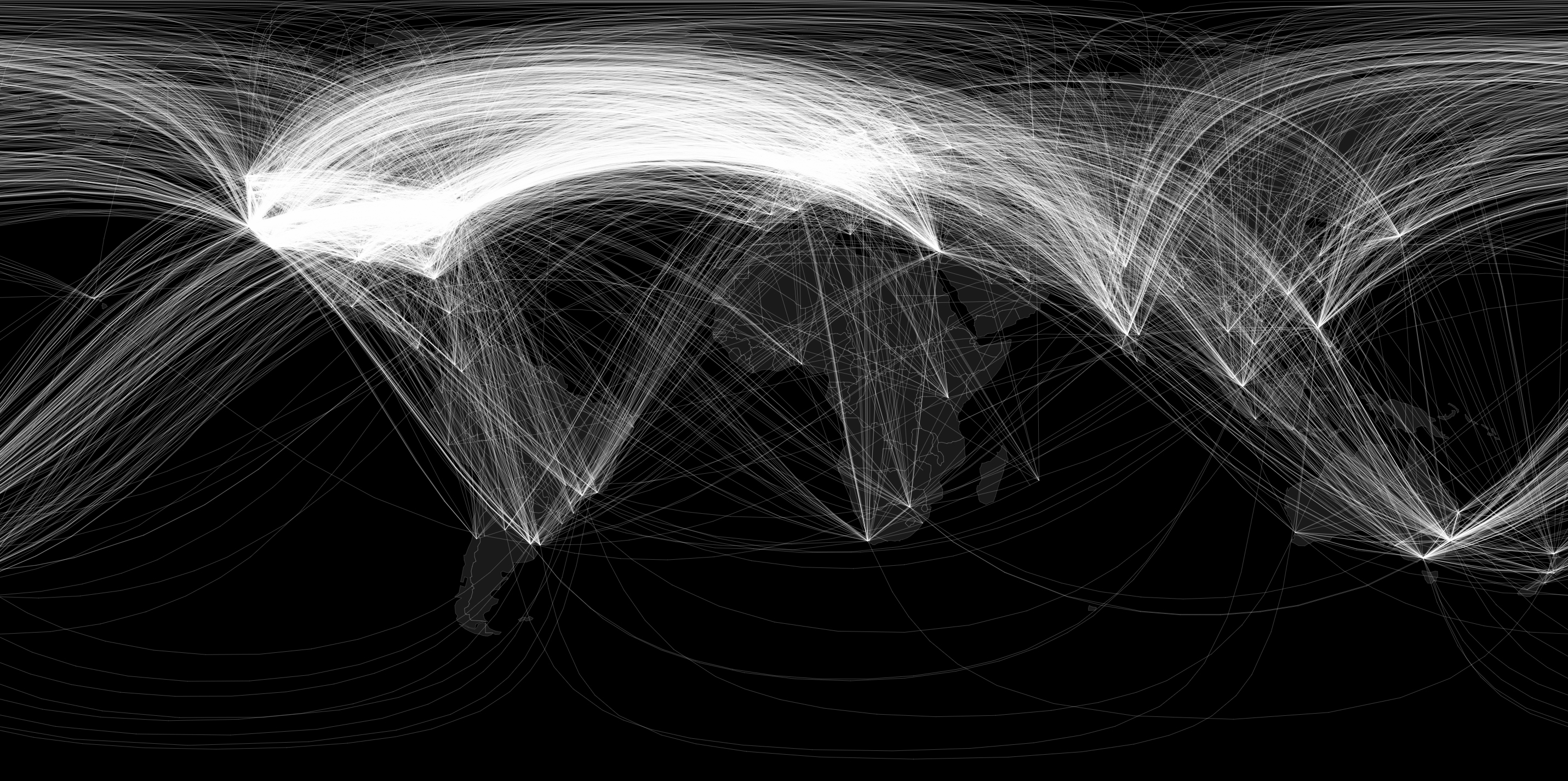
While this visualization ends up undercounting the total number of connections (because so many channels are shared between customers who are the same city as one another) this ends up being really beautiful. It’s like a map of global commerce as seen through Slack shared channels.
Here’s a bonus video showing their growth across the world during our beta period and the few weeks of general availability:
One last note: I’ve been making network-based software for a living for the last 20 years. Over that time I’ve worked on a lot of great projects directly, and have seen many more from the inside, as an investor, board member or just as a friend. I have never been more excited about a product or its product market fit than I am about shared channels.
For the entire beta period, people practically had to walk over broken glass to start using shared channels: for me to even send you an invitation, I’d first have to find out your “workspace URL” which very few people knew. Yet the usage kept growing, and customers kept inventing newer and more valuable uses.
The spread was truly viral: we saw that companies first introduced to shared channels by one of their vendors or partners went on to send invitations themselves to their customers or service providers (who then went on to invite more and more people, and so on). The feature was deemed so essential that some customers even delayed planned upgrades to Enterprise Grid until shared channels were added. The levels of satisfaction and recommendation are through the roof and we’re just getting started. I’ve honestly never seen anything like it.
And that’s why shared channels are so cool.
– Stewart
For more details about how to get the most out of shared channels, take a look at these additional resources:
